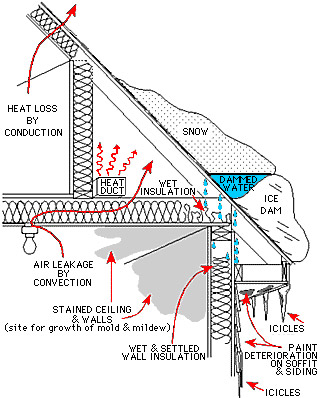Tips to prevent ice dams from forming on your home
As cold weather and snow continue over the next few months in Michigan, homeowners should be on the look-out for dangerous ice dams that can form during freeze-thaw cycles on the edges of a roof.
 According to Michigan State University Extension, homeowners should be on the lookout for ice dams that form at the edge of the roofline during the winter months. These ice dams can cause water from melting snow to back-up underneath shingles. Once this occurs, water leaking inside the attic can cause costly damage to insulation, ceiling and other household items inside the home.
According to Michigan State University Extension, homeowners should be on the lookout for ice dams that form at the edge of the roofline during the winter months. These ice dams can cause water from melting snow to back-up underneath shingles. Once this occurs, water leaking inside the attic can cause costly damage to insulation, ceiling and other household items inside the home.
Ice dams (see graphic) are formed when attic heat warms the roof and melts the snow on the edge of the roof. As snow melts, water runs down under the snow and freezes at the eaves, which are the coldest parts of the roof. Over time, large deposits of ice accumulate forming “ice-dams.” As snow continues to melt off the roof, water will then accumulate (i.e. dam up) behind that large layer of ice and can eventually back-up under the shingles. Once this occurs, water can then leak into the attic space of a home. This can lead to excessive damage to ceilings, walls, insulation and household objects, which can be difficult and expensive to repair.
The key to preventing ice dams is to understand how such problems occur. Homeowners can then take measures to correct the conditions that favor the development of ice dams. The underlying problem leading to the formation of ice dams is undesirable attic heat. Either too little insulation or too little ventilation in the attic is generally the cause. Either condition prevents the roof from staying cold enough to avoid the formation of ice dams on the edges of a roof.
Homeowners should check to see if their attic needs more insulation to prevent the escape of heat from the living quarters or if their roof needs better ventilation. Due to energy crises over the last few decades, most homes are probably now fairly well-insulated. However, that insulation in the attic should not extend over the soffit or eave area of the roof. If it does it will probably keep the eaves too warm and will block soffit vents which let cold air into the attic.
In regards to checking ventilation, there should be an adequate number of inlet vents in the soffit as well as outlet vents at or near the peak of the roof. A variety of devices and materials are available from lumberyards and building supply stores to help increase ventilation into the attic or to better insulate a ceiling.
Homeowners can also use such temporary measures such as removing snow at the eaves with a “roof-rake” or push broom or install electric heat tapes to melt the ice. However, such measures may not prevent ice dams from occurring higher up on the roof if the attic is too warm. Ultimately, homeowners will have to address the real cause of the problem – too little ventilation or too little insulation – if they wish to prevent the formation of ice dams altogether.
Additional information on the causes, prevention and treatment of ice dam problems is available online from the University of Minnesota Extension Service article entitled “Ice Dams.”



 Print
Print Email
Email

